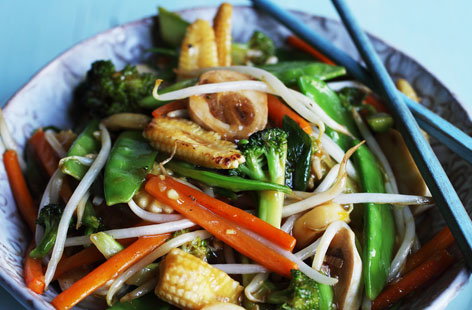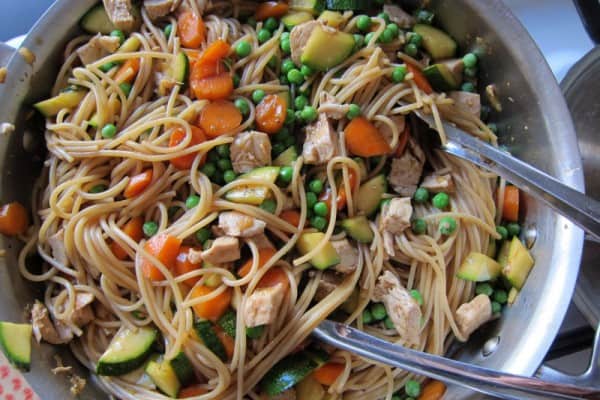Source:- Google.com.pk
Stir frying (Chinese:; pinyin: chǎo) is a Chinese cooking technique in which ingredients are fried in a small amount of very hot oil while being stirred in a wok. The technique originated in China and in recent centuries has spread into other parts of Asia and the West. Many claim that this quick, hot cooking seals in the flavors of the foods, as well as preserving their color and texture.[1]
Scholars think that wok (or pan) frying may have been used as early as the Han dynasty (206 B.C.E. – 220 C.E.) for drying grain, not meats and vegetables, but it was not until the Ming dynasty (1368-1644) that the wok reached its modern shape and allowed quick cooking in hot oil. [2] Well into the 20th century, while restaurants and affluent families could afford the oil and fuel needed for stir fry, the most widely used cooking techniques remained boiling and steaming. Stir fry cooking came to predominate over the course of the century as more people could afford oil and fuel, and in the West spread beyond Chinese communities. [3]
Stir frying and Chinese food have been recommended as both healthy and appealing for their skillful use of vegetables, meats, and fish which are moderate in their fat content and sauces which are not over rich, provided calories are kept at a reasonable level.[4]
The term "stir-fry" was introduced into the English language in Buwei Yang Chao's book How to Cook and Eat in Chinese (1945), to describe the chǎo technique.[5]
In China
Further information: History of Chinese cuisine
The Chinese character "chao" (炒) is attested in inscriptions on bronze vessels from the Eastern Zhou period (771–256 BC), but not in the sense of stir frying.[6] Dry stirring was used in the Han dynasty (206 BC – 221 AD) to parch grain.[2] Although there are no surviving records of Han dynasty stir frying, archaeological evidence of woks and the tendency to slice food thinly indicate that the technique was likely used for cooking.[7]
The term chao appears for the first time in the sense of "stir frying" in the Qimin Yaoshu, a sixth-century agricultural manual, including in a recipe for scrambled eggs. In sources from the Tang dynasty (618–907), chao refers not to a cooking technique, but to a method for roasting tea leaves. It reappears as a cooking method in a dozen recipes from the Song dynasty (960–1279). The Song period is when the Chinese started to use vegetable oil for frying instead of animal fats. Until then, vegetable oil had been used chiefly in lamps.[2]
Historically, stir frying was not as important a technique as boiling or steaming, since the oil needed for stir frying was expensive. The technique became increasingly popular in the late Ming dynasty (1368–1644),[8] in part because the wood and charcoal used to fire stoves were becoming increasingly expensive near urban centers, and stir-frying could cook food quickly without wasting fuel.[9] "The increasingly commercial nature of city life" in the late Ming and Qing (1644–1912) periods also favored speedy methods.[2] But even as stir frying became an important method in Chinese cuisine, it did not replace other cooking techniques. For instance, "only five or six of over 100 recipes recorded in the sixteenth-century novel Jin Ping Mei are stir fry recipes and wok dishes accounted for only 16 percent of the recipes in the most famous eighteenth century recipe book, the Suiyuan shidan".[2]
By the late Qing, most Chinese kitchens were equipped with a wok range (chaozao or paotai zao convenient for stir-frying because it had a large hole in the middle to insert the bottom of a wok into the flames.[2]
In the West
Stir frying was brought to America by early Chinese immigrants, and has been used in non-Asian cuisine.[10]
The term "stir fry" as a translation for "chao" was introduced in the 1945 book How To Cook and Eat in Chinese. It was designed by the author's husband, the linguist Yuen Ren Chao.[11] The book told the reader
Roughly speaking, ch'ao may be defined as a big-fire-shallow-fat-continual-stirring-quick-frying of cut-up material with wet seasoning. We shall call it 'stir-fry' or 'stir' for short. The nearest to this in western cooking is sauté. ... Because stir-frying has such critical timing and is done so quickly, it can be called 'blitz-cooking.'"[12]
In the West, stir fry spread from Chinese family and restaurant kitchens into general use. One popular cookbook noted that in the "health-conscious 1970s" suddenly it seemed that "everyone was buying a wok, and stir frying remained popular because it was quick." Many families had difficulty fitting a family dinner into their crowded schedules but found that stir fry could be prepared in as little as fifteen minutes.[13]
Technique
Broadly speaking, there are two primary techniques: chao and bao. Both techniques use high heat, but chao adds a liquid and the ingredients are softer, where as bao stir fries are more crispy because of the Maillard reaction.[14]
Chao technique
The chao technique is similar to the Western technique of sautéing.[15] There are regional variations in the amount and type of oil, the ratio of oil to other liquids, the combinations of ingredients, the use of hot peppers, and such, but the same basic procedure is followed in all parts of the country.
First the wok is heated to a high temperature, and just as or before it smokes, a small amount of cooking oil is added down the side of the wok (a traditional expression is "hot wok, cold oil"), followed by dry seasonings such as ginger, garlic, scallions, or shallots. The seasonings are tossed with a spatula until they are fragrant, then other ingredients are added, beginning with the ones taking the longest to cook, such as meat or tofu. When the meat and vegetables are nearly cooked, combinations of soy sauce, vinegar, wine, salt, or sugar may be added, and thickeners such as cornstarch, water chestnut flour, or arrowroot may be added.[16]
A single ingredient, especially a vegetable, may be stir-fried without the step of adding another ingredient, or two or more ingredients may be stir-fried to make a single dish. Although large leaf vegetables, such as cabbage or spinach, do not need to be cut into pieces, for dishes which combine ingredients, they should all be cut to roughly the same size.
Wok hei
Main article: Wok § Wok hei
Wok hei (simplified Chinese: traditional Chinese: Jyutping: wok6 hei3; romanization based on the Cantonese Chinese pronunciation of the phrase;when literally translated into English, it can be translated as "wok thermal radiation"[17][18] or, metaphorically. as the "breath of the wok". The second character is transliterated as qi (chi) according to its Mandarin Chinese pronunciation, so wok hei is sometimes rendered as wok chi in Western cookbooks) is the flavour, tastes, and "essence" imparted by a hot wok on food during stir frying.[17][19] Out of the Eight Culinary Traditions of China, wok hei is encountered the most in Cantonese cuisine, whereas it may not even be an accepted underlying principle in some of the other Chinese cuisines.
To impart wok hei the traditional way, the food is cooked in a seasoned wok over a high flame while being stirred and tossed quickly.[17] The distinct taste of wok hei is partially imbued into the metal of the wok itself from former cooking sessions and brought out again when cooking over high heat. In practical terms, the flavour imparted by chemical compounds results from caramelization, Maillard reactions, and the partial combustion of oil that come from charring and searing of the food at very high heat in excess of 200 °C (392 °F).[18] Aside from flavour, wok hei also manifests itself in the texture and smell of the cooked items.
Stir Fry Vegetables Recipe Vegetable Recipes 2015 in Urdu Filipino for Kids Indian Chinese Panlasang Pinoy Images Photos Pics
Stir Fry Vegetables Recipe Vegetable Recipes 2015 in Urdu Filipino for Kids Indian Chinese Panlasang Pinoy Images Photos Pics
Stir Fry Vegetables Recipe Vegetable Recipes 2015 in Urdu Filipino for Kids Indian Chinese Panlasang Pinoy Images Photos Pics
Stir Fry Vegetables Recipe Vegetable Recipes 2015 in Urdu Filipino for Kids Indian Chinese Panlasang Pinoy Images Photos Pics
Stir Fry Vegetables Recipe Vegetable Recipes 2015 in Urdu Filipino for Kids Indian Chinese Panlasang Pinoy Images Photos Pics
Stir Fry Vegetables Recipe Vegetable Recipes 2015 in Urdu Filipino for Kids Indian Chinese Panlasang Pinoy Images Photos Pics
Stir Fry Vegetables Recipe Vegetable Recipes 2015 in Urdu Filipino for Kids Indian Chinese Panlasang Pinoy Images Photos Pics
Stir Fry Vegetables Recipe Vegetable Recipes 2015 in Urdu Filipino for Kids Indian Chinese Panlasang Pinoy Images Photos Pics
Stir Fry Vegetables Recipe Vegetable Recipes 2015 in Urdu Filipino for Kids Indian Chinese Panlasang Pinoy Images Photos Pics
Stir Fry Vegetables Recipe Vegetable Recipes 2015 in Urdu Filipino for Kids Indian Chinese Panlasang Pinoy Images Photos Pics
Stir Fry Vegetables Recipe Vegetable Recipes 2015 in Urdu Filipino for Kids Indian Chinese Panlasang Pinoy Images Photos Pics

.jpg)







No comments:
Post a Comment